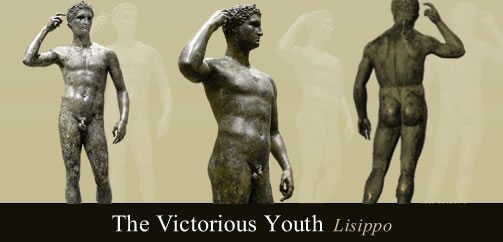The heroic naked

The heroic naked style is born with the Greek art and is one of the motives of his originality, fundamental for the comprehension of his aesthetics as of that Roman that represents the continuation it.
The Greek art distinct itself from all the preceding artistic expression for putting the man in the centre of the own intuitive and representative world, giving to the divinities a human shape: "the Greek art searches in the individual for the ideal type of divine beauty and transfers the nakedness with the contingent reality on a heroic and universal plan".
The complete nakedness in the Greek art is peculiar of the athletes for which to Sparta in the VII century B.C. it was usual to be trained and to compete naked - while the complete female nakedness is peculiar only hetaerae to exception of the type of the naked Aphrodite that had exact cultural meanings.
In the daily life the complete nakedness was whichever esteemed ridiculous or disheartening and disparaging the enemies could be represented naked as a form of insult- from the V century there was an evolution clearly explained by the words of Platon.
"But when training it seemed that it was better to denude that to hide all that parts of the body, also what the eyes were finding ridiculous was made disappearing by what the reason recognised to be better. And this demonstrates that only a superficial man considers somethings ridiculous over what is bad, and that the one who tries to make laughing regarding something like a ridiculous show that is out of the madness or the evil looks made this for a reason different from the good." (Res publica -V, 452 a-e).
It is this rational and conscious freedom of the spirit that is to the base of the Hellenistic philosophy of Prassitele and Lisippo.
The Romans will be conquered by the Greek art but in their vision of the world the nakedness is a dangerous fountain of moral corruption; they refuse the complete nakedness as shameful also for the athletes and Tacitus (Annales XIV, 20) in remembering the games instituted by Nero according to the Greek use (Graeco more) including, as there says Svetonius (Nero, 12), a certamen quinquennale triplex, musicum, gymnicum, equestre, judges it a tool of corruption of the youth.
The Roman model is that one of the toga and of the loricate, but from the late republican age they will manage to portrait themsleves taking from loan models of naked heroic bodies of the great Greek art and the men will have the bodies of Hermes, of Ares, of Zeus, of athletes, the women of Venus, Minerve or of Omphale.
For the Romans it was the face that had to express the identity and the physiognomy of a person more or less realistic and his qualities; the body instead was assuming positions and configurations that were indicating the public list, the career and the action of the represented personage.
The face and the body, as well as making eternal the memory of the represented personage, had also an educational aim: the emulation of his qualities. To make the messages more intelligible, the sculptors encoded a typology of statues that could be mass-produced, so on "ideal" bodies, there were brought variations of suit, of position and of gestures.
The type of the statues was changing also in relation to the place where they were coming erect, so an emperor's statue in the garments of Pontifex Maximus was possible to find it to Rome, while in the province it always had the lorica (armour) or he was presenting himself in heroic nakedness as Claudio in the "Sebasteion of Aphrodisia". But the statues have changed also long the centuries and it was Plinius who tried to classify the statues for typology and the currencies according to two characteristics: the format and the custom. The statues then were distinguished for the format, stale, equestrian or on charriots; by of the custom: in toga, armoured or in heroic nakedness.
The body of the Greek and then Roman statues that retook the canons, it declares a beauty model that today is perceived as eternal in the meaning of "classic", not subject to the fashions, but it is not whichever naturally beacuse it was built according to an arithmetical commensurability model between the parts; the famous doctor Galenus was already informing that the symmetry does not exist in nature but it is an invention with which the man tries to put order into the chaos of the existence.
by M.L. ©ALL RIGHTS RESERVED (Ed 1.0 - 01/04/2015)






